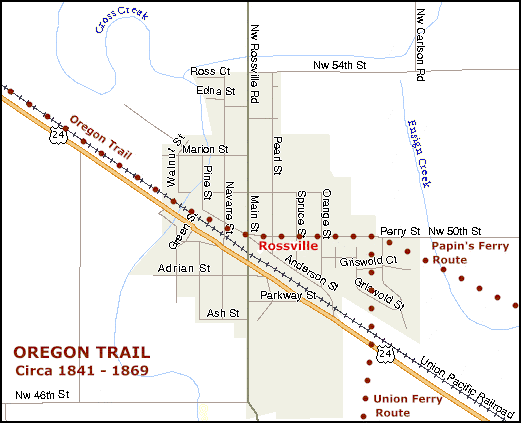|
The
Oregon-California Trail enters Rossville via two separate routes.
Papin’s Ferry Route, the Kansas River crossing in Topeka a half
block downstream from the Topeka Avenue Bridge, enters Rossville from
the east. Union Ferry
Route, the Kansas River crossing south of Rossville near present-day
Willard, enters from the south. Papin’s
Ferry Route is named for Joseph and Louis Papin. The Papin’s were probably the first white settlers in 1842
in what is now Topeka. They
operated the Papin’s Ferry on the Oregon-California Trail until 1857
when a bridge was constructed. Union
Ferry Route is named for the Uniontown Pottawatomie trading post
established in 1848. It was
here that many ‘49ers ferried or forded the Kansas River on the
“Independence” Oregon-California Trail. The
trail split in the town of Big Springs, east of Topeka on Highway 40.
On the east edge of Big Springs is a brick Methodist church, and
a half block west there is a small gravel road coming from the south.
It is at this point that the trail split.
The Papin’s Ferry Route continues generally under or along
Highway 40 to Topeka and the Union Ferry Route branches off to the left
to pass south of Topeka. Papin’s
Ferry Route enters Rossville from the east on Northwest 50th Street.
Union Ferry Route enters Rossville from the south on a gradual
northeast line from where Northwest Carlson Road turns west onto
Northwest 42nd Street, seven-tenths of a mile south of town.
The two trails meet again where Northwest 50th Street
becomes Perry Street on the eastern city limits. In
Rossville the trail continues west on Perry Street to Main Street.
Turn south on Main Street and cross the Union Pacific Railroad
tracks. Looking west the
trail makes its intercept with these tracks and continues beneath them
to the northwest. Highway 24 west parallels the trail, which continues
beneath the tracks west of Rossville to the town of St. Marys. Emigrant
diaries described this country as high rolling prairies, and in the
middle of the 19th century it had little timber and even less
water. As
the road to westward expansion, the Oregon-California Trail was the
pathway to the Pacific for fur traders, gold seekers, missionaries and
others. Beginning in 1841
and continuing through 1869, over 300,000 emigrants followed this route
from Independence, Missouri to Oregon City, Oregon on a trip that took
five months to complete. The
2,170 mile long trail passes through Missouri, Kansas, Nebraska,
Wyoming, Idaho and Oregon.
|
||||||||||||||||||||||||||||||||||||||||||||||||||||||||||
|
Through Rossville |
||||||||||||||||||||||||||||||||||||||||||||||||||||||||||
|
|
||||||||||||||||||||||||||||||||||||||||||||||||||||||||||
